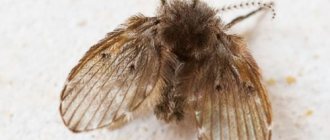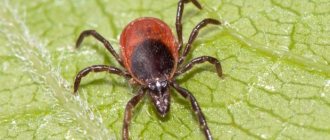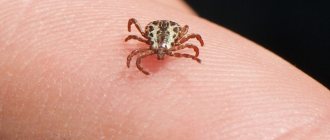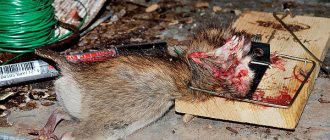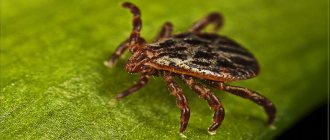What does it look like
A small, barely visible insect, growing up to 2-2.5 mm. The parasite has a brown-yellow body color and transverse black rings along the abdomen. Males are smaller than females and have a more shaded rear part.
In nature, fruit flies actively feed on rotting plant debris, sucking the juice from them, and the larvae also eat numerous microorganisms.
The fly begins to actively reproduce at a temperature of +18⁰С, and when the thermometer increases to +25⁰С, their ontogenesis accelerates 2-3 times. During her short life, a female Drosophila lays up to 400-450 eggs, from which larvae appear after 4-5 days, and after another 5-6 days they grow into full-fledged adult flies.
How it penetrates indoors and where it lives in nature
At the first warming, hordes of these small insects begin to swarm busily in homes. The abundance of available food pushes them to rapid reproduction and population growth.
Flies find themselves inside a house/apartment in various ways:
- through purchased vegetables or fruits, which contain microscopic larvae;
- through open windows (even mosquito nets do not help - their cells are too large to prevent the passage of flies);
- through garden soil, which is used for planting indoor flowers;
- an open aquarium with fish with rare water changes;
- through pet fur after walks.
Drosophila feed on juice from vegetables, fruits, and wood from garden trees. These insects live en masse in gardens and vineyards. They can be found in wine cellars and factory warehouses for processing vegetables and fruits.
In open space, fruit flies can reproduce only at temperatures above +16⁰C.
Drosophila are attracted to decaying products, and the vinegary smell of decomposition calls them to such places. If a pet lives in the house, and its feeder is not cleaned regularly, then the remains of rotting food become an excellent habitat and breeding place for flies.
The population is rapidly increasing in the presence of favorable factors:
- poor house cleaning and hygiene;
- dirty dishes lying in the sink for a long time;
- leftover food on plates;
- crumbs and greasy marks on the dining table;
- a lot of unwashed bottles of sweet drinks and wines;
- old tea leaves in an open container;
- excessive watering of plants and stagnant water in trays and flowerpots;
- when storing fruit outside the refrigerator;
- a long-standing trash bin.
Midge traps
Glass jar 1. Place bait (pieces of fruit, juice or compote) in a glass jar. 2. Roll a funnel out of paper. 3. Make a small hole at the tip of the funnel. 4. Insert the funnel into the neck of the jar, tip down. Tape the joint area with tape.
The midges fly to the smell of the bait, end up in the jar, and it’s difficult to get out because the bottom hole of the funnel is small and difficult to find.
Plastic cup 1. Take a small plastic disposable cup (you can use one for yogurt, etc.). 2. Place bait for midges in a glass: pieces of fruit (apple, peach, nectarine, banana), juice, compote, used tea bag, etc. 3. Place cling film on top of the glass. 4. We make small holes in the film with a thick needle (the size of the hole should be such that the midge can climb in, but not too big, otherwise it will crawl out back). 5. Place the glass where midges often live.
The midges follow the smell, get into the glass, but can’t get out because the holes are small. When the number of midges reaches about 15 pieces, you need to throw the glass in the trash. Repeat the procedure until all the midges are eliminated.
Plastic bag
Place several apple cores in a plastic bag for a day, preferably sour ones. Midges love sour and spoiled things. They will climb into the bag and begin to live there and feed. When they are in a bag, you need to carefully and quickly tie the bag. And throw it away.
Prevention of Drosophila
You need to wash the trash can and do some general cleaning in the kitchen. Remove all leftover food. If you have pets, clean out their bowls regularly, and if they leave food behind, clean out the refrigerator. Don't leave dirty dishes behind. Check bags of vegetables regularly and throw away any that are rotten.
You need to find their “home” - usually it is soggy potatoes, “brooding” or rotten vegetables and fruits. If fruit flies have nothing to eat and nowhere to reproduce, they will gradually disappear on their own, and there is no need to breed them with all sorts of dichlorvos and raptors. You need to remove all food, take out the trash, and do not water indoor plants (if any).
Check under the sink - food debris can remain there and become a breeding ground. They can start in a pumpkin that lies on the closet, or in an onion. Often grown in flower pots of indoor plants. Sometimes they fly into ground coffee. They are diluted in a teapot if you do not throw away the tea leaves.
What harm does
These tiny insects do not carry dangerous infections, and they cannot bite. The human body can receive harm from them through eating fruit affected by larvae in the form of indigestion. They annoy people with their large numbers and intrusiveness, creating discomfort. Flies cause more damage to fruit and vegetable crops. Therefore, you need to be able to cope with these insects.
Destruction options
There are many ways to kill annoying insects. You can use both chemicals and folk, safer measures. There are a wide variety of traps for them. There are enough options for fighting, and everyone will find an ideal effective way for themselves.
Insecticides and other ready-made preparations
An excellent remedy for fruit flies is aerosols and numerous insecticides. Their choice depends on the place that needs to be processed:
In apartments
The best results are shown by Dichlorvos, Raptor, Kombat and Raid. When carrying out treatment, it is necessary to remove four-legged pets and strangers from the premises. After processing, which should be done while using personal protective equipment, wash your hands and after a while ventilate the room well.
Soil treatment
To determine whether there are larvae in indoor plants, slightly lift the top layer of soil. If you find small worms in it, use Actellik or Fitoverm insecticides. But you can simply completely replace the damaged soil by moving the plants into new containers.
Kitchen sinks
If fruit flies have chosen shells for residence, Domestos, Mister Muscle or Mole come to the rescue. You can also simply periodically pour boiling water over the shells.
Knowing that fruit flies cannot tolerate cold, in the cool season you can easily get rid of them by thoroughly ventilating the house. Additionally, turn off heating appliances, open all kitchen cabinet doors wide and provide deep ventilation. The flies will quickly die from hypothermia. Then all that remains is to sweep them onto a dustpan and throw them away.
Expert opinion
Mityuk Stefania Bogdanovna
A regular mosquito fumigator does an excellent job of killing fruit flies. But the plate must first be treated in a solution with toxic substances.
Folk methods of struggle
From the entire list of folk recipes, we can highlight the following methods that have proven to be the most successful and effective:
Camphor
A very effective substance against fruit flies - they cannot tolerate camphor evaporation. To kill parasites, heat pieces of camphor in a frying pan until steam forms and walk around the rooms or garden with it.
Tomato tops
Plant tomato seedlings in the garden or on the windowsill. The flies cannot stand the pungent smell emanating from tomato tops and quickly die.
Essential oils of eucalyptus, anise and basil
These odors are also deadly to flies. The premises are scented taking into account the area - the consumption is 5-6 drops of essential oil per 15 m2 of room.
If flies plague you in the garden, plant bushes of myrtle, geranium, tansy or eucalyptus in the garden plot. The aroma of plants will repel fruit flies and get rid of annoying insects.
Original traps
Fighting tiny flies is a troublesome and time-consuming task. To minimize the loss of time, you can build special traps.
There are several options:
- Traps with liquid . To obtain a bait mixture, sugar syrup and live yeast are used. The substances are mixed in equal proportions and diluted in a small amount of water. The resulting liquids are poured into wide containers (saucers, bowls, deep plates). Traps are placed in the garden or in the corners of rooms. Drosophila, attracted by the sweet smell, flock to the aroma and drown in the thick liquid. Instead of sugar and yeast, you can use any beer, sweet concentrated juice and honey water.
- Vinegar traps . To make the bait, ordinary table vinegar is mixed with dishwashing liquid. The thick solution is poured into small wide glasses and placed indoors or in the garden on verandas and terraces. Every week the solution is changed to a fresh one, and the old one with the fruit flies that got into it is poured out.
- Duct tape . You can buy them in almost any supermarket or hardware store. The adhesive tapes are removed from the packaging and carefully laid out or hung in the habitats of the flies. As fruit flies accumulate on the sticky layer, the traps are replaced with fresh ones. Sticky traps can also be made from double-sided tape. The adhesive tape is cut into fragments and attached to the places where fruit flies are detected using cardboard pieces.
- Potassium permanganate . Such traps are more suitable for flower crops in which fly larvae are found in the soil. Potassium permanganate is diluted in water until a faint pink color is obtained. The surface of the soil in pots is treated with the solution. Antiseptic liquid completely destroys all larvae.
- Traps with mechanics . It's easy to make them. A piece of sweet fruit or slightly overripe berries is placed in a small plastic cup. The top of the glass is covered with ordinary cling film, in which small holes are made. Drosophila flock to the bait, but are no longer able to fly out of the cup. If you don't have cling film on your household, you can use a rolled-up paper cone instead.
Predatory plants
Some plant crops are predators by nature and readily feed on various small insects, including fruit flies.
For example, at home you can plant:
- Venus flytrap;
- Zhiryanka;
- Nepenthes;
- Sundew;
- Sarracenia.
These are indoor types of crops that will rid the premises not only of fruit flies, but also of flies and mosquitoes. When an insect lands on the leaves of such a crop, they slam shut, and the plant eats the victim entirely or sucks out nutrients from it.
Predatory plants are dangerous and poisonous to cats and dogs. Keep this in mind when choosing this option for combating fruit flies.
How to get rid of fruit flies?
Since flies multiply quickly, it is much easier to prevent them from appearing than to get rid of the insects.
How to prevent fruit flies from appearing in your home?
To begin with, stop leaving food and prepared meals on the table; they belong in the refrigerator.
If food, especially rotten food, is left on the table in the summer, fruit flies will appear within a few hours.
If you buy food at a market, especially an open one, there is a high chance that you will bring home not only vegetables and fruits, but also midges. In addition, they are often brought with soil, so be careful when purchasing.
If you notice that the soil in indoor flowers in your home is contaminated, then you need to take action immediately, because midges multiply quickly. The simplest and most effective way is to change the soil. In this case, you need to wash the roots of the flower and thoroughly disinfect the pot. But this method has an important drawback - it weakens the plant and can cause it to wither.
If you have a pet, do not forget to change its food regularly. Sour food attracts not only midges, but also other insects. If you have a pet that lives in a cage (hamster, guinea pig, chinchilla, etc.), then clean the cage and keep it clean: do not forget to change the bedding and remove leftover food. If you have an aquarium in your home, prevent algae from rotting and change the water periodically.
Another way for flies to enter an apartment is through a window. Having a mesh will help prevent flies and other insects from entering.
You should not place a trash can next to the window; it will not only bring an unpleasant smell into the house, but also midges.
Avoid blockages in sinks, as midges can breed in drains and water pipes. To do this, it is recommended to periodically clean the siphon; it is also advisable to use disinfectants or pour boiling water into the sink - this will help destroy insect eggs.
Drosophila, appearance
Drosophila fruit on raspberries, photo
Drosophila fly or fruit fly
How to get rid of fruit flies?
The only way to kill fruit flies is to remove their source of reproduction.
You need to remove all the garbage, go through the fruit bowls and refrigerator, throw out all the food that has spoiled. Carefully examine all the drawers in the kitchen; it is possible that a package, for example, with dried fruits, in which midges have appeared, has been lost somewhere.
Wash your pets' bowls and make sure there is no dried food left on them. Clean the cages, change the water in the aquarium, replace the filler in the tray.
Study your house plants; if somewhere the soil is contaminated, it is also better to throw it out and buy a new one. If you do not want to change the soil, then there is another option: treat the soil with a weak solution of potassium permanganate or stick several matches into the soil with their heads.
Traps for fruit flies
This is the easiest option to get rid of midges, but not the most effective. The disadvantage of traps is that they kill the individuals that fall into the trap, not all of them. But if you just have midges and there are few of them, then traps can help.
There are simple options for making your own baits. For example, you can prepare the following treat for them: take a saucer, pour water with sugar, juice, sweet lemonade into it. The midges will fly up to the treat, fall into the trap and drown.
By the way, if you add a drop of dishwashing liquid to the sweet mixture, the surface tension of the water will be reduced and the effectiveness of the trap will increase.
Another option is a regular apple. As you know, a cut apple quickly darkens and attracts fruit flies. You need to take a plastic cup, put a piece of apple in it, cover the glass with cling film, making holes in it. The trap works as follows: the apple is a bait to which midges will flock and fly into the glass, but they will no longer be able to get out of it. The glass should then be thrown away.
You can get rid of midges by using a glass jar and a paper funnel. You need to put a piece of overripe fruit on the bottom of the jar, and place a funnel on top inside the jar so that the narrow part is directed towards the bottom, but does not reach it. Through the funnel, midges will get inside, but will not be able to fly out.
If you don't want to make your own traps, you can purchase sticky tape. They need to be hung in places where midges bother you. If it gets on the tape, the fruit fly will stick and will no longer be able to get out.
Special means for destroying fruit flies
In stores you can find various poisonous sprays to combat midges: Dichlorvos, Combat, Raid, Raptor, etc.
Please note that the composition of sprays against midges is far from the safest, so before carrying out treatment with the products, be sure to remove children’s clothes and food products. While treating the room from midges, you need to close all windows; after the procedure, leave the house for several hours. After returning, you need to do a thorough cleaning and thoroughly ventilate the rooms.
An effective way to bait insects is to use repellents. A strip impregnated with a special chemical composition is placed in the repellent body; it can repel insects or kill them. The device can be hung in places where there is a source of midge breeding: in the basement, garage, attic, etc.
If you decide to use this option to combat fruit midges, do not forget to ventilate the premises often, since toxic fumes in high concentrations are unsafe for children and pets.
Mechanical influences
You can get rid of midges in your home yourself using simple steps:
- Through ventilation. In this case, the midges will fly out of the house.
- Using a vacuum cleaner. Use a vacuum cleaner to go over all surfaces where midges sit. But do not forget that after such cleaning you need to immediately clean the vacuum cleaner container.
- Use of aromatic oils. Midges cannot tolerate some smells, so if the room smells like verbena, cloves, ylang-ylang or patchouli, then the midges will disappear.
- Use of camphor. The aroma of this medicine is also extremely unpleasant to midges. To clean the room, grind camphor, place it in a heated frying pan, the vapors will disperse throughout the apartment and save you from annoying insects.
- Ventilation during the cold season. Midges are sensitive to low temperatures, so if you notice the appearance of insects in winter, you can get rid of them by simply airing them. Open all kitchen cabinets and windows at night, and the fruit flies will die from hypothermia.
Midges in the house are a nuisance and cause irritation, but getting rid of them is a troublesome task. The best option is prevention. Keep your house clean, do not allow garbage to be stored for a long time, take care of indoor plants and pets, and in this case your house will be clean and annoying midges will not bother you.
Preventive actions
Knowing what exactly attracts parasites indoors and in gardens, you can prevent their occurrence by destroying the provoking factors:
- do not leave liquid food in animal bowls; wash dishes immediately after eating;
- remove food debris and keep plates and glasses clean;
- keep fruits in the refrigerator;
- after a walk, wash the paws of four-legged pets and clean their fur;
- in gardens, the soil in places where plants are planted must be mulched; straw and fallen leaves are suitable as mulch;
- close the waste bin tightly and empty it regularly;
- regularly ventilate rooms, especially in cool weather;
- do not store spoiled products, but dispose of them immediately;
- Maintain proper cleanliness both indoors and in your garden areas.
What means do you use to combat fruit flies?
TrapsChemistry
If fruit flies have settled next to indoor flowers, all fallen leaves must be immediately removed from the pot and thrown away. And before planting plants in soil purchased in a store, bake it in the oven to prevent and destroy larvae.
An ordinary match will help prevent larvae from multiplying in the soil for indoor flowers. It should be stuck with a sulfur head into the soil.
The Drosophila fruit fly can appear anywhere, in a garden, vegetable garden or apartment. No one is safe from the invasion of these tiny insects. But you can quickly get rid of annoying midges using the effective methods that we told you about. And compliance with preventive measures will prevent the reappearance of flies.
How to get rid of small midges in the house?
How to deal with small annoying creatures? There are quite a few ways to get rid of an apartment or house from small but big “interference”.
Forced hunger strike
Human housing attracts insects because the owners “willingly” share food even with unpleasant neighbors, and also create ideal conditions for their existence. What is the most desirable thing for midges in the house? This is dampness, the smell of fruit, fermentation or rotting. These are the ideal conditions because these are the places to lay eggs.
The first task of the owners is to deprive midges of such foci, since getting rid of insects, but not eliminating ideal conditions for them, will lead to the fact that midges will reappear in the home in the near future. Therefore, first of all, you need to get rid of:
- all spoiled or uneaten fruits;
- leftover food in feeders and trays of pets;
- wet, undried sponges, rags, napkins and mops;
- contaminated water in aquariums, as algae may begin to rot in it;
- habits of accumulating waste, especially wet household waste;
- fears that plants will certainly die without abundant watering, since an emergency is more likely to occur for another reason - due to diseases or “albino” pests.
To ensure the absence of flying “nuisance” in the future, you need to stop watering indoor plants with tea leaves, or water remaining after washing the meat. Instead of this “dangerous” organic matter, it is better to use real fertilizers that will not cause guests to “come”.
What to do with midges in flowers?
How to get rid of small midges in the house if they are in pots with plants? In this case, it is recommended to use sharp aromas, which are “not to the liking” of many flying “irritants”.
They don't like the smell of geranium, they are afraid of tomatoes, they are afraid of garlic and horseradish. To combat midges, vegetables are cut into thin slices and then placed in pots. However, this method of control is controversial, because midges settle on spoiled spicy vegetables no less readily.
To ensure that the threat is eliminated, the soil must be protected. Several means are used as emergency measures:
- ground pepper, which is scattered on the surface of the soil;
- matches, they are stuck with sulfur heads into the soil;
- orange peels on top;
- tobacco, which is sprinkled on the substrate.
However, a weak solution of potassium permanganate is considered the most effective. It is dissolved in water in such quantities that the liquid acquires a pale pink color. Then the flowers with the “settlers” are watered with this solution. If it was not possible to get rid of the midges the first time, then the operation is repeated, but the next watering is possible only after 2 days.
If there are a lot of pests, then it is better to replace the top part of the soil with a new layer, but this is only a half-measure. The best option would be to transplant the plants into soil calcined in the oven. It is recommended to wash the roots of flowers before changing their place of residence.
To prevent reoccupation, a good drainage system must be installed. Reducing the amount of water for irrigation remains the main condition. To prevent water from stagnating, the soil must be loosened regularly.
How to get rid of small midges in the kitchen?
Midges that have infested in a room where there are no indoor plants, as a rule, are the most annoying and cause maximum inconvenience. The reasons for this invasion are products that are freely available. Therefore, you must first eliminate all potentially attractive objects. Typically, “cleaning against midges” is done like this:
- Remove everything from the table that could attract small insects. These are containers from yoghurts, juices, cups of unfinished tea or coffee, used tea bags.
- All kitchen working “tools” are disinfected and dried - sponges, rags, napkins, containers for storing them, etc.
- Clean the sink (sink) and siphon; it is better to disconnect the last element. Flush the pipes.
- The garbage from the bucket is thrown into the trash, the container itself is thoroughly washed and wiped.
After all the “goodies” for the midges have been removed, they move on to the second stage - removing the flying nuisance itself. The first option is repellent scents. The midge does not like the smells of cloves, basil and eucalyptus, so it is given unbearable living conditions:
- Pour a glass of water into a small container, place it on the fire and bring to a boil. Then add 5 grams of cloves to boiling water, which is boiled for several hours, adding water regularly.
- Camphor oil is heated in a frying pan. Then the dishes are carried throughout the house, stopping for a long time in places captured by the “enemy.”
- Light the aroma lamp with eucalyptus for 2 or 3 hours.
After completing the work, do a wet cleaning, and then all rooms are well ventilated. Not only kitchens are attractive to midges, but also rooms with similar conditions - bathrooms or washrooms. But other types of insects already live there. Therefore, it is necessary to carefully monitor the cleanliness of “wet” rooms, appliances and pipes, and ensure good ventilation or regular ventilation of small rooms.
